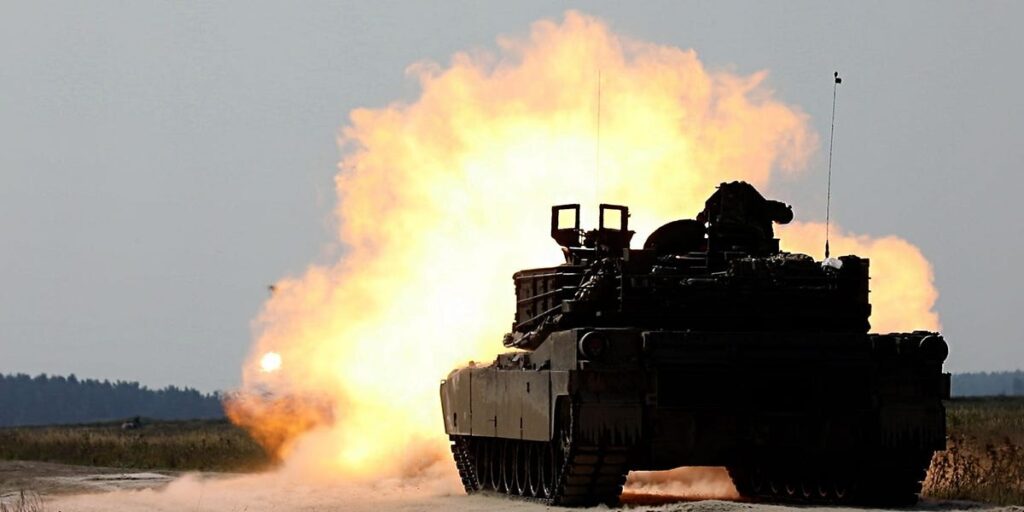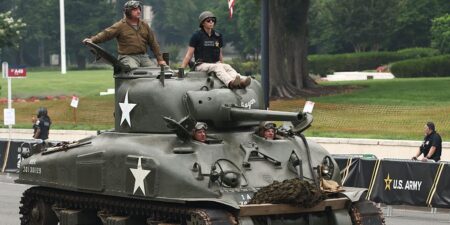The tank isn’t dead, US Army Secretary Daniel Driscoll told Business Insider. They have a role in the Army, but how they are used in battle will need to change as threats evolve.
The heavy destruction of tanks and armored fighting vehicles in Ukraine led to speculation that the main battle tank is obsolete, that this weapon that has played a role in countless conflicts since its emergence during World War I may no longer have a place on battlefields rife with classic threats like mines and newer ones like anti-tank missiles and exploding drones.
But the Army’s top civilian official says that may be off.
“Where people have started to predict the death of the tank, I think they’re misunderstanding what probably will happen,” the former armor officer said.
Driscoll, now two months into his job as the secretary of the Army, was in Alaska last week to observe the Army’s Arctic-trained soldiers, members of the 11th Airborne Division training for cold-weather combat in one of the harsher Indo-Pacific environments.
While talking with BI about the challenges of future war, including space and cyber assets and uncrewed systems, Driscoll noted that the way the tank goes to war will have to change due to the threats it faces.
In a potential future conflict, Army tanks won’t necessarily be the first assets to hit the front line, to lead breach operations. Soldiers may not see the kind of armor-led combined-arms assaults they’ve seen in previous conflicts.
Instead, autonomous vehicles and other uncrewed systems supported by other assets would be the first to engage. “The tank will sit back out of reach of these drones, or at least in more defensible positions,” Driscoll said.
Once a path has been opened, it can enter the fight, providing the protected firepower it has long brought to the battlefield.
“Once you’re able to break through with autonomous vehicles and robots and cyber warfare and help from space assets,” the Army secretary said, “you will then probably start to see a lot of the most powerful weapons on planet Earth, which is the M1A2 tank, roll forward and continue to get in the fight.”
Driscoll’s comments speak to a growing interest across the US military in using uncrewed systems for first contact. Drone operators and US military officials have focused on drones as a way to reduce risks to human personnel, whether that be in combat operations, gathering reconnaissance, or assessing threats.
But above all, his remarks highlight the ongoing concerns about the vulnerability of the tank to drones, anti-tank weapons, mines, and other threats, as well as operations without the kind of air superiority the US enjoyed in its wars in the Middle East, and the need to adapt.
Throughout the war in Ukraine, combat footage has repeatedly shown small quadcopters and other drones dropping bombs on battle tanks or flying in through open hatches and exploding.
Cheap drones worth a few hundred bucks have taken out expensive tanks worth millions, ushering in a whole new era of asymmetric warfare. Loitering munitions, another kind of uncrewed aerial system, have likewise been devastating.
And it isn’t just Soviet-designed tanks that have fallen prey to drones and loitering munitions. Western tanks, too, have been lost, including American-made Abrams.
The US supplied Ukraine with 31 Abrams tanks, while other NATO nations supplied Leopards and Challengers. These tanks have been of decreased utility. They are high-value targets, the tank-on-tank battles they were built for are not happening frequently, and there simply aren’t enough of them.
Kyiv’s forces have gotten more from armored fighting vehicles like the Bradley, even using one to beat a Russian T-90M. Ukraine received significantly more of these, making losses more acceptable. Crews still see value in their tanks though.
In response to the drone threat, both sides began employing countermeasures to defend battle tanks from drones, such as putting metal cages on turrets and around vulnerable areas. Both the Abrams and the Bradleys have received these upgrades. Electronic warfare has also been heavily employed.
While the tank’s future role has been called into question, the specific values the weapon brings to battle continue to be recognized. That said, the tank and its tactics are likely to be an ongoing discussion for militaries.
In August 2023, over a year into the war in Ukraine, Army officers and experts wrote that the tank’s lethality, survivability, and mobility as part of combined arms operations, as well as the ability to place them on land anywhere around the world, are of tremendous value.
The authors also noted the importance of teamwork to identify and counter weaknesses. “In the US Army, the tank is not a solo performer. It constitutes part of an ensemble of capabilities organic to the armored brigade combat team that both supplement the tank’s inherent qualities and mitigate its vulnerabilities,” they wrote.
“Such teamwork,” they said, “ensures the continued relevancy of the tank despite the proliferation of unmanned aircraft systems, loitering munitions, precision artillery, antitank guided missiles, and electromagnetic spectrum considerations.”
Electronic warfare, mobile air defenses, and other capabilities could be important to keeping the tank in the fight. The authors of the report, titled “The Tank is Dead … Long Live the Tank,” said that drones and other threats “necessitate adaptation rather than outright removal from the battlefield” for the tank.
The US and other top militaries have also continued to invest in battle tank programs while prioritizing better armor protection and maneuverability. The AbramsX, a General Dynamics Land Systems design concept for a next-generation Abrams tank, for example, was designed to be lighter, more agile, and more survivable.
The US Army is also employing lessons from Ukraine in training, boosting its response to increased drone proliferation.
Army leaders have previously told BI that it’s important for soldiers to recognize the threat of uncrewed systems on the battlefield, explaining that “you have to look up, you have to look 360” degrees and increase situational awareness to avoid being caught by surprise in battle.
Read the full article here
















